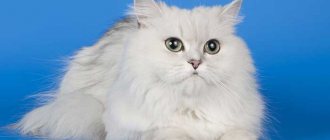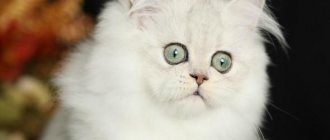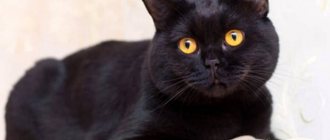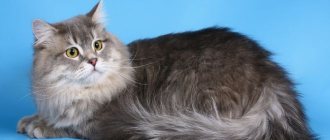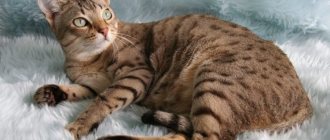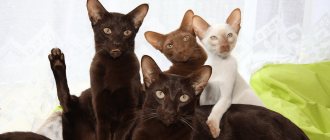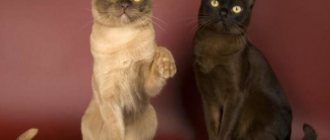Maintenance and care
Straights cannot be called overly active, they will not rush around the apartment for hours and are not prone to jumping from the chandelier to the curtains, but they do not mind playing from time to time.
The owner should think about toys and gymnastic devices that you can buy or build yourself. Physical activity will help maintain a cheerful spirit and good shape throughout the pet’s life, which is especially important for cats and kittens that do not leave the apartment
Another feature of the Scots is their passion for unusual poses. Many of them like to sleep on their backs or “sit on their butts.” Without experiencing any discomfort, they can stand in columns for a long time, begging for food or a toy.
In the private sector, Scottish cats will happily walk in the garden. Here they can bask in the sun and chase flies to their heart's content. Cats usually don't go far, but unneutered cats can easily disappear for several days. It is dangerous to let out an apartment cat that is not accustomed to walking. She may get scared of something, run away and get lost.
The Scottish Straight is an exclusively domestic cat that does not require frequent walks. However, if you organize entertainment and games for him in the fresh air, a pet of any age will thank you.
This animal has a rare quality for cats - resistance to stress. Thanks to this, straight-eared Scots can easily cope with moving to a new place of residence, long trips, and a change in their usual environment. Usually they quickly and painlessly adapt to unusual conditions and get used to new faces.
Care
There is nothing difficult about caring for plush cats.
Once or twice a week they are combed, paying attention to the areas behind the ears, on the stomach and the back of the paws. Do not forget to trim the cat’s claws on time, if necessary, wipe the cat’s eyes and clean the ears.
The Scottish Straight takes any hygienic procedures calmly, especially those that are familiar from childhood, or even enjoys them. Owners of this breed often note that their pets are not only not afraid of water, but are also drawn to it, love to play with the stream or drink from the tap. You can bathe them only if absolutely necessary: if they are heavily soiled, after molting, before an exhibition.
It is important to remember that plush wool rolls very poorly and is removed from the stomach. To avoid clogging and related problems, from the age of six months the kitten is taught to take special pastes for hair removal.
If the plush coat is not brushed regularly, shedding will be noticeable. Heavy seasonal hair loss occurs twice a year and lasts for several weeks; the rest of the time, hair loss is mild or moderate.
Nutrition
Scottish cats can be fed with ready-made food, dry or with braces. A diet is selected depending on age and physiological state. You can also feed your Scotsman natural products. It is better to create a diet with a specialist, veterinarian or breeder.
Make sure that your animal's diet contains as little food as possible that is high in fat and salt. Their regular use will lead to the development of obesity in your pet, and gradually it will become lethargic and inactive.
It is important that the food meets all the pet’s needs and is healthy and balanced. A mixed diet is possible, but not recommended.
If you need to add industrial food to natural food, then it is better if it is wet food, the digestive system is already adapted to digesting it. Any changes in feeding should be gradual. Your pet must have clean water freely available, even if he prefers to drink from a tap or an aquarium.
Character of Scottish Straight cats and cats
Scottish kittens are characterized by sedateness, independence and importance, at the same time they are active, inquisitive animals. They very quickly get used to a new place, among all the people living in the house
They immediately single out one person and unconditionally recognize him as a leader; a Scottish Straight cat will adore this person and follow on his heels. In the absence of people, he gets bored and always meets them at the doorstep, like a faithful dog.
With other family members, the Scots remain neutral and behave kindly; they are wary of strangers. They get along excellently with children, taking part in children's fun with pleasure. Kids, in turn, treat the charming teddy bears with delight and literally do not let go of the kitties.
However, parents should keep the situation under control, since straight-eared Scots cats cannot stand affection, squeezing, or being forced to be held in their arms, and when they break free, they can inadvertently scratch the child. They like much more to lie next to the owner, clinging to the person with their warm plush side. They rarely allow themselves to be petted and only when they want it.
Peace-loving, not at all touchy and unforgiving character, lack of aggressiveness make Scottish straight cats ideal companions for older people, and favorite pets for families with children (taking into account the points mentioned above about “cuddling”).
Straights easily find a common language with other animals living in the house: even with hamsters, even with dogs. They catch mice, and this “hunting” quality further increases the attractiveness of the breed.
Scottish Fold cats are not couch potatoes, unlike Persians, they are playful, but in moderation, they cannot be called too active, so you should not be afraid that in your absence they will cause disturbances in the house. They do not like heights and climbing curtains; exploring the wardrobes from above is not among their interests. Another thing is the inside of the closet, where a curious Scot will not hesitate to stick his charming nose.
Scottish Straight cats are not talkative; their meow can be heard extremely rarely, only if the animal is in pain or asks to be fed. More often they make peculiar sounds, reminiscent of creaking, or simply silently open their mouth.
Kittens quickly learn to use the toilet and scratching post. The last point is especially important, since straights have such a sin - they like to sharpen their claws on furniture or wallpaper.
History of the breed
The first representative of the Scottish Straight breed was little Susie. The unusualness of the cat was noticed by the Great Briton William Ross. It was this cat that was noticed on one of the private Scottish farms in the 19th century - it had ears of an unusual shape.
The animal was a carrier of a special mutation gene (FdFd), due to which the ears were folded. It was from this that the Scottish Fold (loose-eared Scots) breed originated.
A more detailed history of the origin of Scottish cats can be read in the article about the Scottish Fold.
Characteristics of the Scottish Fold breed (Scottish Fold)
In a nutshell, we can say that the genetics of Scots are theoretically quite simple: if one parent is fold-eared, there is a 50/50 chance of getting the same kittens. But practice shows that fewer lops are born than straights. You can recognize the sign of lop ears in kittens by about 5 weeks of age.
The Scottish Fold has relatively low maintenance and care requirements. This breed does not require special handling. To be happy, this breed requires a clean environment, plenty of food and, above all, the sympathy of its owners. Scottish Folds have a sense of humor and frolic when their owners play and laugh with him. His appearance alone already puts anyone in a good mood. The head of the Scottish Fold cat is well rounded, with a firm chin and well-developed jaws. The muzzle should have noticeable and well-rounded whisker pads. The head smoothly turns into a short, strong neck. The cheeks are well developed, especially in Scottish cats. The eyes are wide open. Large, round, widely set. Eye color generally matches coat color. The Scottish Fold has a wide nose with a slight transition. A small stop is acceptable, but a noticeable stop is considered a fault. The profile is soft, moderately streamlined. The ears are folded forward and down. Small, the smaller the better. Small, well-proportioned ears are preferred. The ears of a fold cat should be set in such a way as to emphasize the rounded skull. The tips of the ears should be rounded. The body is medium in size, rounded, in proportion to the level of the shoulders and croup. The cat is strong, densely built, but without a hint of fatness or lack of mobility due to short, rough limbs. The feet are very neat and well rounded, with five toes on the front feet and four on the hind feet. Scottish Fold cats can be slightly smaller than male cats. The tail is medium to long, but proportional to the body. The coat of the Scottish Fold is short, dense, plush, and uniform. Coat texture may vary depending on color or regional and seasonal variations. The length of the coat is medium-long to long. Abundant hair on the face and body is desirable, but short hair is allowed on the face and limbs. “Panties”, tail feathering, tufts of hair between toes and ear feathering should be clearly visible, a collar is desirable. A serious drawback of adult animals is cotton wool. The colors of the Scottish Fold can be divided into several conditional groups - solid (saturated - black, red, chocolate, lightened - blue, lilac, cream), tortoiseshell, smoky, chinchilla, patterned (tabby) and colored point In most cases, the eye color of Scottish cats should be orange or copper, but there are exceptions, for example, emerald or intense golden eyes of chinchillas and silver shaded colors, blue eyes in color point cats.
Standards
One of the most popular breeds appeared in the 60s of the last century in Scotland. After much controversy, Australians were the first to differentiate straight-eared and fold-eared cats from the British breed and set standards for their appearance.
How to now distinguish a Scottish cat from a British one read here →
Do you know why cats love valerian?
You can learn about sterilization and castration of cats and female cats from this material.
Scottish straights (straight ears)
- Torso . The animal is of medium size, muscular, rounded body contours. The paws are short and strong, the toes are well compressed. The tail is usually long or medium (to the center of the shoulder blade), mobile. Males are noticeably larger than cats.
- Head . The Straight's skull is convex, its muzzle and cheeks are round. Boys have especially full cheeks. Strong, moderately protruding chin, medium-length nose. The neck is short: the cat’s seemingly thick cheeks immediately turn into the neck.
- Ears . The “locators” of the Scottish straight-eared kitten, although small, are impressive: widened at the base, set high and quite wide, the tips pointed and spread to the sides, the outer surface of the ear is lowered almost parallel to the head.
- Eyes . Probably, it was the straight that we saw in the cartoon “Shrek” - the childish expression of large round eyes captivates in an instant. The color is in harmony with the color.
- Nose . A short nose with a smooth back and a moderate profile play into the hands of the cat’s touching pug.
- Wool . The fur coat of a straight kitten is thin, but dense and plush. The length is medium, tightly covering the body.
- Deviations . It is no secret that if the mating is incorrect or there are deviations in the genes of the parents, the kitten may have defects in appearance that prevent both participation in the exhibition and a normal lifestyle. In Scottish Straights this is often a too short and stiff tail, with a hook at the end, heavy movements, arched back, loose ears, incorrectly placed limbs and creaking in the joints.
Scottish Folds (loose-eared)
- Torso . Contrary to beliefs, folds are distinguished from straights not only by the shape of their ears. The body of a fold cat is medium to large in size, muscular, with a powerful neck. The paws are low and thick. The tail is often short, thick, with a round tip.
- Head . The profile of the Fold is impressive - wide nose, large whisker pads, full cheeks, short muzzle, strong chin and wide round head.
- Ears . Very small, forward-curved ears give the breed a special charm. They favorably emphasize the roundness of the head, pressing well against the skull.
- Eyes . The look of a fold-eared kitten is touching. Large eyes are widely spaced, very often slanted, which, however, touches even more.
- Nose . This part of the fold's muzzle is similar to that of the straight, but often the nose is slightly wider and shorter.
- Wool . The fold-eared breed has thick, short, non-adherent hair; the range of colors, like the straight-eared ones, is very wide.
- Deviations . The most common defects in the appearance of Folds are any deviations of the spine and tail, irregular ear shape and number of toes.
How to keep a chinchilla at home. Description of all features of care and maintenance.
Is it true that the smell of cat urine cannot be washed away by anything? Read how to get rid of it here.
How to properly care for a pregnant cat: https://kotovasia.net/...ojj.html
How did the breed come about?
The name of the animal suggests that the Scottish Straight cat is a child of Scotland. However, some experts claim that this breed was found in the east in ancient times.
Be that as it may, the reason for the formation of the straight-eared Scots breed was... the drooping ears of the Fold breed. In the early seventies of the last century, an interesting, although not sensational, event occurred in Scotland - a British cat gave birth to kittens with unusual drooping ears. Breeders were very interested in such offspring. It was decided to increase the number of fold-eared cats. This is how fold beauties arose. It is fair to say that this breed has captivated the hearts of millions of people.
The first steps towards the development of the breed were quite complex and dramatic. When crossing Scottish Folds, kittens with bone abnormalities began to be born. This is where the Scottish straight-eared cats came in handy, “pairing up” with the handsome fold-eared cats. The kittens were born strong and hardy, the breeders were happy. But the attitude towards Scottish Straights was neutral - they were used only to resolve the issue of healthy heirs of the Fold subspecies. But gradually interest in the charming and peace-loving pussies of the Scottish Straight increased, many owners wanted to acquire favorites of this breed.
At the official level, the Scottish Straight became a separate breed only ten years ago. Until this time, Straights were considered a British breed. Interestingly, it was in Russia in 2004 that the Scottish Straight was first called the “Scottish Shorthaired Straight”. Then there was world recognition of the breed.
Health and life expectancy
Scottish cats have good health and good heredity, unlike their fold-eared relatives. No serious genetic diseases or defects were found in them. With good care, nutrition, timely vaccinations and antihelminthic measures, the first serious diseases appear only in adulthood. Usually these are arthrosis and arthritis, diseases of the genitourinary system and digestive tract. Life expectancy is 11-13 years.
Choosing a Scottish Straight kitten
Today, Scottish cats are bred by all and sundry. Many lines are weak and the kittens from them do not grow up with the clear breed characteristics that are expected of them, and sometimes they are even mixed breeds. Therefore, the choice of a baby should be taken seriously.
Before you buy a Scottish Straight, you should look at kittens from the best nurseries live or at least in photos. If you are not planning to purchase a high-quality baby, then this will help you compare a high-quality kitten with other offers and significantly narrow your search.
With the right coat, kittens should look round and soft and plush. The heads are round, the ears are elastic, widely spaced, the tips are directed slightly to the sides. The tail at the base is quite voluminous, and the legs are strong.
You should also pay attention to your health. Externally, the baby should not show signs of illness
It should be clean with shiny fur and clear eyes, and a moderately rounded tummy. Character must be taken into account. It will be very difficult with someone who is too active, fearful or aggressive, and someone who is too calm is unlikely to please an active person. Kittens that are too frightened and “squeezed” are unlikely to become brave adult cats.
It is worth deciding in advance on the ultimate purpose of the purchase. For exhibitions, sofa or breeding. But here it is worth noting that suitability for shows, as well as for breeding, can only be reliably assessed in adult cats. No one can guarantee that a kitten will grow up to be a standard. This can only be assumed by assessing it with an experienced eye. Breeding class means that a male cat has very good breed characteristics that can be passed on to offspring. Just how is this confirmed in a two-month-old baby?
First of all, you need to take a healthy, pedigree kitten. If for some reason he cannot be exhibited or participate in breeding, he must remain desired and loved.
There are a wide variety of colors, it's a matter of taste. It is also impossible to say for sure which gender is better. Each option has its own pros and cons. If personal experience is not enough, they are worth reading about separately. You can pick up your baby by 2.5-3 months of age. By this time, he is already weaned from his mother’s milk and care, and his growing curiosity and desire to study the world around him will help him quickly adapt to his new home. With a kitten, the new owner must get a vet. a passport with marks of the first vaccinations and a metric, which is then exchanged for a pedigree.
Price
Scottish kittens are very different in quality, and hence the difference in price. Good straights cannot be cheap, but they are not as in demand as folds, so their price is usually a little lower. In addition, the cost is influenced by the class of the kitten, the status of the nursery, the merits of the parents and geography. Pet-class kittens cost 15-25 thousand rubles. (the need for their further castration/sterilization is usually specified in the purchase agreement). For exhibitions and breeding - from 40,000 rubles. If we are talking about babies without documents, the price ranges from 1-10 thousand rubles, but no one can guarantee that the father of the offspring was not a neighbor’s cat.
How much does a Scottish Fold kitten cost?
The cost of a kitten can vary from 3 to 15 thousand rubles, depending on the class, pedigree, prestige of the nursery and, of course, color. For example, Scottish straight chinchilla or ticked will cost more than white or blue.
You can buy a baby in specialized nurseries; there are more than enough of them in Russia. There you will be given a veterinary passport for the baby, which includes vaccinations, metrics, and advice on feeding and maintenance issues.
Experienced breeders do not recommend buying pets on the market, according to advertisements on the Internet. Of course, the animal will cost less, but in this case no one will give you a guarantee that it is healthy and purebred.
You can pick up your baby from the nursery no earlier than 2 months, since teddy bears cannot do without breastfeeding.
How are breeds classified?
For the first time, purebred cats began to be bred in Asia solely for decorative purposes, while in Europe these animals were still used to kill rodents. That is why they are classified by appearance, and not by activity, like dogs.
Only those individuals who have a document - a pedigree - are considered purebred. It is issued by clubs that are members of one of the international felinological organizations. They approve breed standards, the procedure for holding exhibitions, and also exercise control over the work of nurseries. The most famous among them:
- WCF (World Cat Federation). This organization is considered the most authoritative and numerous. Her standards are very strict. WCF was founded in 1988 in Rio de Janeiro (Brazil) and is now headquartered in Essen, Germany. This federation includes more than 500 clubs of cat lovers from all over the world.
- TICA (International Cat Association). This organization was founded in 1979 in the USA, later it became international. TICA is considered the main association that deals with felinological exhibitions.
- FIFe (International Cat Federation). Appeared in Belgium in December 1950. At first it included only cat federations of European countries, and in 1972 the Brazilian Club joined FIFe. Since then it has become international. This organization is one of the members of the World Felinological Congress (WCC).
Each of the federations listed above uses its own criteria to classify cat breeds. However, most often furry pets are divided according to the following parameters:
- body type;
- coat length;
- color;
- type of drawing.
According to their body type, cats are divided into 6 groups:
- Heavy type. These are the largest representatives of domestic cats. They have a powerful tail, strong limbs, a massive and short neck. The most famous representatives of this type are Siberian cats and Maine Coons.
- Kobby (stocky). Such cats have a dense build, a wide chest, a massive head, a short and wide nose, a short neck and paws, and a short tail. Typical representatives are menx and exotics.
- Oriental. Representatives of this group have a graceful physique, an elegant neck, rather long limbs and tail, as well as a muzzle narrowed towards the nose. The most famous are Siamese, Javanese and Balinese cats.
- Foreign. These cats have long limbs and a tail, almond-shaped eyes, a wedge-shaped head, and a flexible and muscular body. Sometimes representatives of a foreign group have elongated ears, but this sign is not obligatory. The most famous representatives of this type are Abyssinian cats.
- Semi-foreign. Cats of the semi-foreign group have average body parameters. They are more common than representatives of other types. The most famous representatives are Russian Blue and American Shorthair cats.
- Half-cobby. These cats are very similar to the half-foreign ones, but the half-cobbies are a little stockier. Famous representatives are British Shorthair cats.
Depending on the length of their fur, cats come in the following varieties:
- Long-haired. The fur length of all representatives of this type is approximately 15 cm. They need regular washing and combing, otherwise they will look untidy. This variety includes Burmese, Siberian and Persian cats.
- Short-haired. Typical representatives: Egyptian Mau, Russian Blue and Carthusian cats.
- Wirehaired. The most famous are American Wirehair cats.
- Cats with curly fur. Typical representatives: German Rex and Cornish Rex.
- Hairless. The most popular are Sphynxes and Bambinos.
There are a great variety of colors of purebred cats, which are also divided into several main types:
- single-color (Havana, Korat);
- bicolor (ragdoll, Norwegian forest cat);
- tortoiseshell or multi-colored (Persian cat, bobtail);
- motley (Angora cat);
- maroon (Persian chinchilla, American shorthair cat).
Cats are also classified depending on the type of pattern on their coat:
- solid (brown, black, red, gray and others);
- white with small markings of various shades;
- plain white;
- silver (cameo, chinchilla, smoky);
- zonal (spotted, striped);
- color point (light body and dark paws, ears, tail).
How to choose the right kitten
It will be difficult for a non-professional to determine the differences in these breeds at an early stage in the animal's life. Basically, everyone relies on the words of the breeder. But many people, unknowingly, want to adopt a British Fold. There is no such breed. It’s not worth chasing after some fairy-tale pet. Before making a choice in favor of one or another kitten, you should carefully familiarize yourself with the characteristics of their appearance, behavior, and possible health problems.
A self-respecting breeder will definitely offer to get acquainted with the pedigree and show the parents of the offspring. This should be taken more than carefully. For example, after 2004, mating of British and Scottish Fold breeds was officially prohibited. If the kitten’s mom and dad were born later and had similar crosses in their pedigree, then the breed is not pure. It is also not allowed to cross two fold-eared cats. Such seemingly small nuances can later become a serious problem:
- Changes in the appearance of kittens in future litters.
- Inability to participate in international exhibitions.
- Serious physical problems: from general weakness to skeletal mutations and incurable diseases.
Of course, such global negative moments happen quite rarely. But you shouldn’t take the risk and buy a kitten. Folds have a semi-lethal gene, so events can unfold in completely different scenarios.
Health
Scots with ears of both types have good immunity. But hypothermia or prolonged exposure to the sun is extremely dangerous for pets. Vaccination can protect your animal from many serious illnesses. And yet they are prone to the following diseases:
- Urolithiasis disease. More often it occurs in cats than females. The animal often pees and experiences pain. Sometimes blood inclusions are visible in the urine. If this problem occurs, you should immediately contact a veterinarian.
- Cardiomyopathy . These are heart problems, expressed by difficulty breathing, shortness of breath.
- Ear diseases, such as: ear mites, otitis media.
- Discharge from the eyes . Moderate and clear discharge from the eyes is normal, due to the special structure of the muzzle. But if your eyes are swollen or the discharge has turned color, you should consult a doctor.
- Obesity . These animals have a genetic predisposition to obesity, so make sure that the animal eats properly.
Scots live up to 15-20 years of age, but only with proper care and a routine examination by a veterinarian.
What is the difference between a Scottish fold and a Scottish straight?
All types of Scottish cats have an excellent temperament, which allows them to be an excellent companion for families with children; they get along well with dogs and cats (and even other breeds); and a Scot is an ideal partner for a single person.
Scottish cats are represented by two breeds - the Scottish Fold (Scottish Fold) and the Scottish Shorthair (Scottish Straight - a cat with straight regular ears, born from a fold-eared parent). The Scots also have a long-haired version - Highland Fold (Scottish Fold Longhair) and Highland Straight (Scottish Straight Longhair).
The division into Scottish Fold and Straight-eared cats arose out of vital necessity, since matings are allowed only between Straight-eared and Straight-eared sires and nothing else. And the breeding of these breeds “in itself”, i.e. mating of two straight-eared or two fold-eared sires is strictly prohibited.
We can say with absolute confidence that today the time of undeserved inattention to long-haired Scottish cats has ended. Today you can increasingly see charming Highlands at dog shows!
At the end of 2005, beginning of 2006. two Moscow nurseries imported new producers from the USA, Scottish Longhair male and female
The attention of breeders and breed lovers turned to the original and unusually beautiful Highland Folds and Straights. Highlands are cats with a gentle and loving character.
Like all Scots, they are sociable, inquisitive, and cheerful. They get along well with other animals and children. They are completely devoid of aggression.
The undoubted advantage and adornment of the Highlands is their long, fluffy coat. Its texture is noticeably different from Persian and requires significantly less care. The Highland's coat does not mat or mat; it only requires periodic brushing about once a week, and then only to remove dead hair and prevent it from appearing on the carpet or sofa. Otherwise, long-haired Scots do an excellent job of caring for their coats themselves, just like their short-haired relatives. Shorthaired Scottish cats have long been known to all cat lovers. Their character is exactly the same as that of the long-haired Scots. And the short, plush fur of Scottish cats with a thick undercoat amazes with the abundance of colors!
Grooming for shorthaired Scots is minimal. As a rule, it consists of periodically trimming the claws and combing during the molting period.
How much does a Scottish Fold kitten cost?
Due to its popularity and demand on the market, there are a lot of offers of Scottish Fold kittens on the market, so a kitten of this breed can be purchased from 1 thousand rubles (of course, the quality and health of the kitten in such an offer is difficult to guarantee). In Russia, the average price of Scottish Fold kittens is from 5 to 12 thousand rubles (according to the message board for the sale of kittens cat.pet2me.com). Kittens from nurseries from champion parents cost between 15 and 20 thousand rubles. In Moscow, average prices for Scottish Fold kittens are slightly lower than the Russian average, ranging from 4-12 thousand rubles. In Ukraine, kittens of this breed are cheaper than in Russia from 1000 hryvnia to 2000 hryvnia (these are average prices), there are prices even higher, but this is only if you intend to participate in exhibitions.
Origin of Scottish cats
It’s hard to believe, but the Scottish breed did not appear as a result of the ideas of breeders and their long, painstaking work.
The first Scottish kitten was the result of a natural genetic mutation that unexpectedly occurred about fifty years ago in an ordinary white cat from Scotland.
The kitten was born with small, floppy ears. For a long time it was considered simply defective and no interest was shown in this peculiar animal. This could have continued and such an amazing breed would not have been born if not for William and Mary Ross. The couple liked the cat with strange ears, and when she grew up and gave birth to kittens, they acquired one of her cubs - a girl who was christened Snooks.
When Snooks grew into an adult cat, she was matched with an ordinary domestic cat. Their litter included two kittens with the same floppy ears as their mother. The history of Scottish fold cats began with these kittens.
Scottish Folds or British Folds, as they are also called, due to the fact that they are descended from British Shorthair cats, are still not officially recognized in Scotland as a separate, self-sufficient breed of cat. Which is quite strange - after all, they originated from there. This is due to the fact that Scottish veterinarians have concerns regarding the ears of this breed. They believe that their structure can lead to deafness of the animal or to the spread and development of various infections.
In the litter of cats of the Scottish breed, both fold-eared kittens and kittens with straight ears are born. This is the main feature of the Scots. This phenomenon is explained by the fact that when mating, one of the parents must have straight ears. Only in this way can the gene that determines lop ears be passed on to one of the offspring with a fifty percent probability. If you try to breed a Scottish cat with a Scottish cat, the kittens from their litter will have unpleasant birth defects.
At the beginning of 1970, in England they decided to stop working on Scottish breeding, as they discovered problems with the musculoskeletal system due to the genetic characteristics of the breed. At the same time, American geneticists were able to preserve the mutation of the ears, eliminating problems and harm to the health of fold-eared cats. In 1980, the breed gained popularity and veterinarians had to recognize it and define standards for Scottish representatives. In 1994, the American Cat Fanciers Association officially recognized the Scottish Fold as a separate breed.
What is the difference between the British and Scottish breeds?
Scottish Straight kittens have very small ears that curve forward. Unlike British cats, Scottish cats:
- graceful and light;
- their head is round in shape;
- longer body.
On average, Scottish Fold and Scottish Straight cats weigh three to three and a half kilograms, cats four to five kilograms. The British are heavier and larger than their Scottish counterparts.
It is often believed that there is a British Fold breed, but this is not true. There is a British Shorthair, but it has its own standards and is not a fold-eared cat.
Breeders sometimes cross Scottish and British cats and cats, but these species have long been separated. Crossbreeding is used to obtain new rare colors.
The most recognizable features of appearance
It is worth recognizing that the Scottish Fold is still more popular today than its straight-eared brothers. But, on the other hand, caring for a Scottish Straight is less burdensome for the owner. In addition, the appearance of straight-eared pussies is very elegant, a little “childish”.
Let's look at the most recognizable features of the Murka's appearance:
- proportional, strongly built body (an adult cat usually weighs up to four kilograms, and a male on average weighs 5 kg);
- the body is dense, roundish (the Scottish Straight looks robust, but the cat cannot be called fat);
- limbs of medium length, paws – neat, round;
- cats of this breed have a short neck, a rounded head, with pretty convex cheeks;
- ears are small and stand straight;
- the holes are large, round (spaced widely), their color is “dictated” by the color of the animal’s fur;
- the tail is flexible, of medium length;
- Another interesting feature of cats is that having a muscular, massive body, these animals are very mobile. For them, standing on their hind legs and begging for a treat is as easy as shelling pears.
Both subspecies of the Scottish breed have either short or semi-long hair. In the second case, the cat is called Highland. That is, there is both the Scottish Highland Fold and the straight-eared variety - the Highland Straight.
Not a single description will fully reflect the grace of movements that make the Scottish Straight pussy very attractive, nor will it convey the touching (sometimes naively sad) expression on the face of this fluffy beauty. Photo competitions for cat lovers are often full of hilarious photographs of the furry favorites of this breed. It must be said that long-haired pussies - Highland - look the most majestic and chic.
British KSH breed
GCCF STANDARD
General description: The BCS is a compact, strong, harmoniously built cat.
The head is round, with well-developed cheeks, wide at the cheekbones, which emphasize its round shape. The neck is short and thick. The nose is short, wide, straight. In profile, the round forehead transitions into a short, straight nose (the transition should not be very obvious, but noticeable).
The chin is strong and level. The nose and chin are vertical.
The ears are medium in size, rounded, low and wide set.
The eyes are large, round, wide open, set wide apart.
The body is squat, cobby-type, the back is straight and short. The chest is wide. The shoulders are broad and massive, as are the hips. Medium to large in size, but not loose body. Legs and paws – the legs are short, thick, the paws are round, strong, dense.
The tail is thick, of medium length, rounded at the end, wide at the base.
The coat is short, thick, shiny, dense, with a thick undercoat. A coat that is too soft and/or too long and/or close-lying is a fault.
The cat must be healthy, in good show condition and well prepared.
Flaws
- Incorrect bite, “twist”, knots on the tail, skeletal deformities.
- The coat is too long, too soft, too close-fitting.
- Excessive stop.
- Underbite, weak chin and jaws.
- Pinch, too pronounced mustache pads.
Head and ears …………………………………… 20 Eyes ……………………………………………………….. 10 Body, legs and paws … …………………….. 25 Tail ………………………………………………………. 10 Wool (texture, length) … 20 Color ……………………………………………………… 15 100 points
Scottish cat character
Since childhood, a Scottish breed kitten displays all the features of a future adult cat with all its advantages and disadvantages.
These are kind creatures, but you should not at all correlate external plushness with character: these pussies are very capricious and can surprise with attacks of self-will. At the same time, cats do not like to show aggression and are loyal to younger family members. But this does not exclude the ability to stand up for oneself if the child wants to pull the cat by the tail.
The Scottish kitten loves to socialize, have fun with its owner, and play an active game with a person. Even a grown-up cat will not play dirty tricks behind the owner’s back. In any case, if an animal is guilty of something, it will not pretend that it is not its fault.
Touchiness and vindictiveness are also not among the characteristic traits of the breed.
Despite his ability to get along with other animals, a jealous Scot will try with all his might to take first place in the house and, most importantly, in the heart of the owner.
Scottish longhaired fold
Highland Folds are the most unusual “Scots”. Fans call them alien cats because of their folded ears and luxurious long hair. Moreover, Highlands have even shorter ears than Scottish Folds. This pet looks like a living fluffy ball.
The gene for long hair is recessive. In order for fluffy “Scots” to appear in the litter, both parents must be its carriers.
The character of the longhaired Fold is just as calm and balanced. But the owner may face two difficulties - the cat’s susceptibility to joint diseases (due to genes for lop-earedness) and long hair, the care of which is more difficult than short hair.
Photos of Scottish Longhair Fold cats:
Diseases of lop-eared and straight-eared Britons
Fold-eared and straight-eared Britons do not have diseases that would be characteristic of their breed. But some individuals may exhibit genetic diseases.
Such diseases include:
- Degenerative joint diseases. They reduce the mobility of Scottish cats and cause unpleasant and painful sensations.
- Hereditary heart disease.
- Polycystic kidney disease.
- Various eye diseases.
- Diseases of the gastrointestinal tract.
If Scottish kittens have avoided the genetic transmission of such diseases, then they are unlikely to get sick often, as they are distinguished by good health and endurance.
With good upbringing and care, Scottish cats will not cause any problems. These cute, calm creatures are not capable of upsetting their owners; they only bring joy. Scottish Folds are understanding and sophisticated creatures - by purchasing such a kitten, you will not only become the owner of an elite purebred cat, but also get a faithful friend for your family.
Scottish cat - care
Special care for the Scottish Straight and Fold is not needed, however, owners need to take into account some features of the breed:
- Scottish cats are very picky about the toilet and demand the same attitude from their owners. The litter box must always be washed and filled with fresh litter, otherwise your pet will spit in the wrong place. Find out effective methods on how to train a kitten to use a litter box in an apartment.
- You need to bathe your Scottish Straight no more than once every 2 weeks; the cost of disobedience will be the cat’s beautiful fur being damaged or a cold. This is especially true for long-haired breeds.
- During the shedding season, your Scottish Fold needs to be brushed daily; during normal times, this procedure can be done only 1 day a week.
